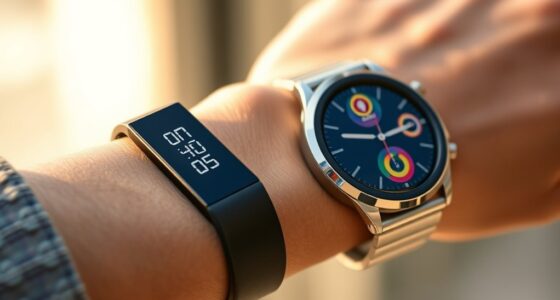Your team’s collaboration can be greatly affected by individual chronotypes, as biological sleep preferences shape peak productivity and alertness times. When members work against their natural rhythms, communication delays and fatigue can occur, reducing effectiveness and creativity. Mismatched schedules may cause misunderstandings and lessen engagement. By recognizing these differences and introducing flexible scheduling, you foster smoother teamwork and better outcomes. You’ll discover effective strategies to optimize team harmony as you continue exploring this topic.
Key Takeaways
- Mismatched chronotypes can cause communication delays and misunderstandings within teams.
- Recognizing diverse sleep patterns fosters inclusivity and stimulates creative problem-solving.
- Aligning tasks with team members’ peak alertness improves overall collaboration effectiveness.
- Flexible schedules that accommodate individual chronotypes reduce fatigue and enhance team cohesion.
- Valuing chronotype differences builds trust, boosts morale, and optimizes team productivity.
Understanding Chronotypes and Their Biological Basis

Understanding chronotypes begins with recognizing that our internal biological clocks regulate when we feel most alert and awake throughout the day. These clocks are influenced by genetic markers, which are specific variations in our DNA. Circadian genes play a vital role by controlling the timing of our circadian rhythms—our natural sleep-wake cycles. Variations in these genes determine whether you’re naturally inclined to be a morning person or a night owl. This biological basis explains why some people perform best early in the day, while others peak later. Recognizing the genetic influence helps you understand that chronotypes aren’t just habits but deeply rooted biological differences. These differences shape your alertness patterns, impacting how you approach work, rest, and social interactions.
How Morning and Evening Preferences Influence Work Styles

Your work style is shaped by whether you’re most productive in the morning or at night. Understanding these preferences helps you optimize collaboration timing and boost team efficiency. Adjusting tasks to fit individual rhythms can make a significant difference in overall performance. Recognizing the importance of sustainable practices in work routines can also contribute to long-term productivity and well-being.
Morning vs. Night Productivity
People’s natural circadian preferences profoundly shape their peak productivity times, with some feeling most alert in the morning and others in the evening. Your sleep quality plays a significant role in determining whether you’re more productive early or late. A well-rested body is sharper, enabling you to focus during your preferred hours. Diet influence also impacts your alertness; consuming balanced meals can enhance morning energy or sustain evening productivity. If you’re a morning person, a nutritious breakfast fuels your day, while night owls often perform better after light, energizing snacks. Recognizing these patterns helps optimize your work schedule, ensuring you tackle challenging tasks when you’re naturally most alert. By aligning your work hours with your chronotype, you can boost overall efficiency and well-being. Additionally, understanding sleep quality can help you better adapt your routines to your natural rhythms, further enhancing productivity.
Collaboration Timing Strategies
Since team members have different peak productivity times, aligning collaboration strategies with their chronotypes can greatly enhance overall effectiveness. You can start by encouraging good sleep hygiene, ensuring everyone gets quality rest that supports circadian alignment. Schedule collaborative tasks during times when most team members are naturally alert — morning for larks, evening for owls. Flexibility is key; allow team members to contribute when they’re most focused, even if it means adjusting meeting times. Clear communication about individual preferences and peak hours helps avoid unnecessary fatigue and improves engagement. By respecting these natural rhythms, you create a work environment that promotes most favorable performance and reduces burnout. Incorporating circadian alignment into your planning fosters smoother collaboration and better overall team dynamics. Recognizing the importance of sleep hygiene can help reinforce healthy routines that support these natural patterns.
Adjusting for Personal Rhythms
Understanding how morning and evening preferences shape work styles allows you to tailor tasks for maximum productivity. Your personal energy levels fluctuate throughout the day, influenced by your chronotype, which impacts your focus and efficiency. By adjusting tasks to align with your natural rhythms, you can optimize daily routines and reduce fatigue. For example, if you’re a morning person, schedule high-concentration tasks early, while evening types might reserve challenging work for later in the day. Recognizing these differences helps you avoid forcing routines that don’t match your biology. This approach fosters better time management and minimizes burnout, ensuring your work aligns with your natural energy peaks and troughs. Additionally, being aware of sleep patterns can further refine how you plan your workday to match your biological clock. Ultimately, customizing routines based on personal rhythms enhances both individual performance and overall team collaboration.
The Role of Chronotype in Determining Peak Productivity Times

Your peak productivity times depend heavily on your chronotype, with some people reaching their best focus in the morning and others in the evening. These differences lead to variability in when team members are most alert and engaged. Understanding these individual patterns helps optimize collaboration and project planning. Additionally, recognizing dog names that suit different personalities can aid in fostering a positive team environment.
Morning vs. Evening Peaks
Chronotypes particularly influence when individuals reach their peak productivity during the day. Morning types often feel energized early, while evening types hit their stride later. Your sleep quality and circadian alignment determine whether you’re naturally aligned with these peaks or struggle against them. When your schedule matches your chronotype, you experience smoother energy flows and better focus. Conversely, misalignment can cause fatigue and reduced efficiency. Recognizing your peak times helps you plan tasks accordingly. Here’s a glimpse of how different chronotypes experience their prime:
| Morning Types | Evening Types |
|---|---|
| Wake refreshed | Feel sluggish early |
| Focus sharp | Creativity peaks |
| Energized early | Motivation late |
| Sleep early | Sleep late |
| Productive mornings | Productive nights |
Aligning work with your biological rhythm boosts performance and well-being. Being aware of your biological rhythm allows for better synchronization of work schedules and improves overall productivity.
Variability in Focus Hours
Since peak focus hours vary widely among individuals, your chronotype plays a crucial role in determining when you’re most productive. Your sleep habits influence your energy levels, shaping the times you feel alert and motivated. Recognizing this variability helps you optimize your work environment and schedule accordingly. When you align tasks with your natural productivity peaks, you experience a sense of accomplishment and reduced stress. Conversely, forcing yourself to work during low-energy periods can lead to frustration and burnout. Embracing your unique focus hours allows you to:
- Feel more energized and engaged throughout your workday
- Minimize distractions caused by fatigue
- Improve overall performance and job satisfaction
- Cultivate a healthier work-life balance
Understanding your focus hours empowers you to work smarter, not harder. Additionally, being aware of best anime movies and other entertaining content can provide refreshing breaks that boost your focus during peak hours.
Individual Chronotype Differences
Understanding individual differences in chronotype is essential for pinpointing when you’re naturally most productive. Your sleep habits, shaped by your internal clock, influence your peak alertness times. Early risers thrive in the morning, while night owls hit their stride later in the day. Social jetlag, caused by misalignments between your biological clock and social schedules, can disrupt these natural patterns, leading to fatigue and decreased focus. Recognizing your unique chronotype helps you schedule tasks during your ideal hours, boosting efficiency. It also highlights the importance of managing sleep habits to minimize social jetlag’s effects. By understanding these differences, you can tailor your routines to enhance productivity and well-being, avoiding burnout caused by forcing yourself into unsuitable schedules. Additionally, awareness of toilet flushing mechanisms can improve routines related to hygiene and water conservation, contributing to overall health and efficiency.
Impacts of Mismatched Schedules on Team Dynamics

When team members have mismatched schedules, collaboration becomes more challenging and less efficient. Differences in sleep habits and social jetlag create gaps that hinder effective communication and coordination. You might notice delays in responses or misunderstandings, which can slow progress and breed frustration. Mismatched schedules often lead to feelings of disconnect and isolation, making teamwork less cohesive. Social jetlag can cause fatigue, reducing productivity and creativity. Such discord hampers trust and morale, ultimately affecting project outcomes. Recognizing these impacts helps you understand how essential synchronized routines are for team harmony. Addressing schedule mismatches isn’t just about efficiency; it’s about fostering a supportive environment where everyone feels engaged and valued. Additionally, understanding the role of attention in creative practice can help team members develop strategies to stay focused despite scheduling challenges, thereby enhancing overall team resilience.
Strategies for Aligning Tasks With Individual Chronotypes

Aligning work tasks with individual chronotypes can considerably boost team productivity and well-being. To do this, understand each team member’s sleep cycles and circadian rhythms. Encourage flexibility by assigning demanding tasks during peak alertness periods, which vary based on whether someone is a morning or evening type. Use tools like sleep logs or circadian rhythm assessments to identify *best* work windows for each person. Consider flexible scheduling or shifting deadlines to match natural energy peaks. Promote open communication so team members can share their preferences and challenges. Additionally, providing access to portable camping gear can support remote or outdoor work arrangements, enhancing flexibility and comfort. By tailoring tasks to individual biological rhythms, you help reduce fatigue and improve focus. This approach not only enhances performance but also fosters a supportive environment that respects personal chronotypes, leading to more harmonious collaboration.
The Effect of Chronotype Diversity on Creative Problem Solving

When your team includes both morning larks and night owls, you tap into a wider range of creative ideas. This diversity in sleep patterns can spark innovative solutions that might not emerge in a more uniform group. Balancing these different chronotypes helps foster an environment where creative problem solving thrives.
Diverse Sleep Patterns Boost Creativity
Diverse sleep patterns within a team, driven by different chronotypes, can considerably enhance creative problem solving. When team members have varied sleep cycles, it sparks fresh perspectives and innovative ideas, fueling creativity. However, a sleep disorder or chronotype mismatch can hinder this potential, leading to frustration or miscommunication. Embracing these differences encourages resilience and adaptability, inspiring breakthroughs. Recognize that:
- Unique sleep schedules foster dynamic thinking, discloseuntapped solutions
- Overcoming sleep disorder challenges can strengthen team cohesion and trust
- Diversity in sleep patterns sparks emotional engagement and passion
- Respecting each other’s chronotypes creates an inclusive, supportive environment
Morning vs. Night Owl Dynamics
The differences between morning larks and night owls profoundly influence how teams approach creative problem solving. Your team’s sleep habits and exposure to social jetlag shape the timing of idea generation and collaboration. When diverse chronotypes work together, they can cover more hours productively, but misaligned schedules may cause friction.
| Morning Lark | Night Owl |
|---|---|
| Peak alertness early | Peak alertness late |
| Prefer quiet mornings | Thrive at night |
| Less affected by social jetlag | Suffer more from social jetlag |
| Often complete tasks early | Delay tasks until late |
| Share common sleep habits | Differ in sleep patterns |
This diversity can foster creative solutions but requires awareness of social jetlag’s impact on team harmony.
Balancing Teams for Innovation
Balancing teams for innovation requires understanding how different chronotypes influence creative problem solving. When team members have varied sleep habits and experience social jetlag, their peak alertness times differ, impacting collaboration. Embracing this diversity can spark fresh ideas and foster breakthroughs. By aligning tasks to individual chronotypes, you empower each person’s natural energy cycles, boosting creativity. Recognize that social jetlag may hinder consistent participation and idea generation. To optimize innovation, consider flexible schedules that accommodate sleep habits and chronotype differences, encouraging open communication and mutual respect. When you value these differences, your team becomes more adaptable, inventive, and resilient.
- Feel the surge of inspiration when unique sleep patterns are celebrated
- Overcome frustration from misaligned schedules and social jetlag
- Experience the thrill of diverse perspectives fueling breakthroughs
- Cultivate an environment where innovation thrives through understanding
Managing Collaboration When Team Members Have Different Rhythms

When team members have different chronotypes, coordinating their efforts requires intentional strategies. You should recognize that varying energy levels throughout the day can affect productivity and communication. To manage this, schedule critical discussions during times when most team members feel alert and engaged. Encourage open communication about individual sleep quality and energy patterns, so everyone understands each other’s rhythms. Flexibility in deadlines and task assignments allows members to work when they feel most energized. Be mindful that poor sleep quality can diminish focus and collaboration, so promoting healthy sleep habits benefits the entire team. By acknowledging these differences and adapting your approach, you create a more inclusive environment where everyone’s unique rhythms support overall team success.
Implementing Flexible Scheduling to Enhance Team Performance

Implementing flexible scheduling can considerably boost team performance by accommodating individual energy peaks and troughs. By using sleep tracking and chronotype assessment, you gain insights into each team member’s natural rhythms. This allows you to create work schedules aligned with their *ideal* productivity times. When you adapt schedules, you foster a sense of trust and value, boosting morale. You’ll notice increased engagement, better focus, and higher quality work. Flexibility helps reduce burnout and promotes well-being, making your team more resilient.
- Feel the pride of supporting each person’s unique rhythm
- Experience heightened motivation and enthusiasm
- Witness improved collaboration and communication
- Celebrate a healthier, more energized team environment
Recognizing and Valuing Chronotype Differences in the Workplace

Recognizing and valuing chronotype differences in the workplace builds on flexible scheduling by emphasizing that each person’s natural rhythm is a key asset. By doing so, you acknowledge that cultural differences influence how people align with their peak productivity times. Some cultures may prioritize early risers, while others value night owls, shaping workplace norms. Understanding these variations helps you adapt leadership styles to support diverse chronotypes, fostering inclusivity and engagement. When you recognize these differences, you create an environment where team members feel appreciated for their unique rhythms. This approach encourages open communication, builds trust, and improves collaboration. Ultimately, valuing chronotype diversity enhances team dynamics and boosts overall performance by making everyone’s strengths visible and respected.
Future Directions for Chronotype-Informed Team Management

As research on chronotype continues to advance, future team management strategies will increasingly integrate personalized scheduling tools and data-driven insights. You’ll be able to tailor work hours based on employees’ natural rhythms, reducing issues caused by time zone differences and social jetlag. This approach can boost productivity, engagement, and well-being across your team. By addressing individual chronotypes, you help employees perform at their best when their energy peaks. Overcoming social jetlag and aligning work schedules with natural sleep patterns will foster a more harmonious workplace. Imagine a future where everyone’s unique biological clock is respected, leading to happier, healthier, and more efficient teams.
- Experience genuine connection as schedules align with personal rhythms
- Reduce burnout caused by mismatched work hours across time zones
- Cultivate a resilient, motivated workforce driven by understanding
- Transform your team into a model of personalized, empathetic management
Frequently Asked Questions
Can Chronotype Influence Team Communication Effectiveness?
Yes, your sleep patterns and productivity cycles can influence how effectively you communicate within a team. When your chronotype aligns with work hours, you’re more alert and engaged, leading to clearer, more timely exchanges. Conversely, if your natural rhythms clash with team schedules, it may cause misunderstandings or delays. Recognizing individual chronotypes helps optimize communication, ensuring everyone’s productivity cycles support better collaboration and more efficient team interactions.
How Does Chronotype Impact Conflict Resolution Within Teams?
You see conflict resolution in teams influenced by sleep patterns, mood, and decision making. Early risers tend to approach conflicts with calmness, clarity, and patience. Night owls might struggle with focus, impulsively react, or delay resolution. By understanding these differences, you can adapt communication, foster patience, and create strategies that align with team members’ chronotypes, helping everyone navigate conflicts more effectively and reach consensus faster.
Are There Specific Industries Where Chronotype Alignment Is More Critical?
In certain industries, industry-specific scheduling and cultural influences make chronotype alignment more critical. For example, healthcare and emergency services require shift work where aligning schedules with natural rhythms improves performance. Similarly, global companies must consider cultural influences that affect sleep patterns and work habits. You’ll find that understanding these factors helps optimize productivity and well-being, ensuring teams work efficiently while respecting individual biological tendencies.
What Are the Long-Term Effects of Ignoring Chronotype Differences?
Ignoring chronotype differences can lead to long-term effects like sleep deprivation and productivity decline. When you don’t respect individual sleep patterns, you risk disrupting natural circadian rhythms, which causes fatigue and reduces your efficiency over time. This ongoing imbalance hampers focus and decision-making, ultimately impacting your overall well-being. To avoid these issues, it’s essential to recognize and accommodate varying chronotypes in your daily routines and work schedules.
How Can Organizations Measure and Assess Team Chronotype Diversity?
Imagine revealing the secret code to your team’s perfect rhythm! To measure and assess team chronotype diversity, you can use assessment methods like chronotype questionnaires or wearable tech that track natural activity patterns. Combine these with diversity metrics to analyze variations in sleep-wake cycles. This approach reveals who’s a morning lark or night owl, helping you optimize schedules and boost collaboration, making your team unstoppable.
Conclusion
Think of your team as an orchestra, each member with their own unique rhythm. When you tune into these differences—honoring morning larks and night owls—you create harmony instead of discord. Embrace flexible schedules and respect individual peaks, turning diverse chronotypes into a symphony of productivity. By valuing each person’s rhythm, you’ll orchestrate a collaborative environment where everyone plays their part best, leading to a masterpiece of team success.









